automatic transmission TOYOTA AVENSIS 2011 Owners Manual
[x] Cancel search | Manufacturer: TOYOTA, Model Year: 2011, Model line: AVENSIS, Model: TOYOTA AVENSIS 2011Pages: 772, PDF Size: 34.43 MB
Page 3 of 772
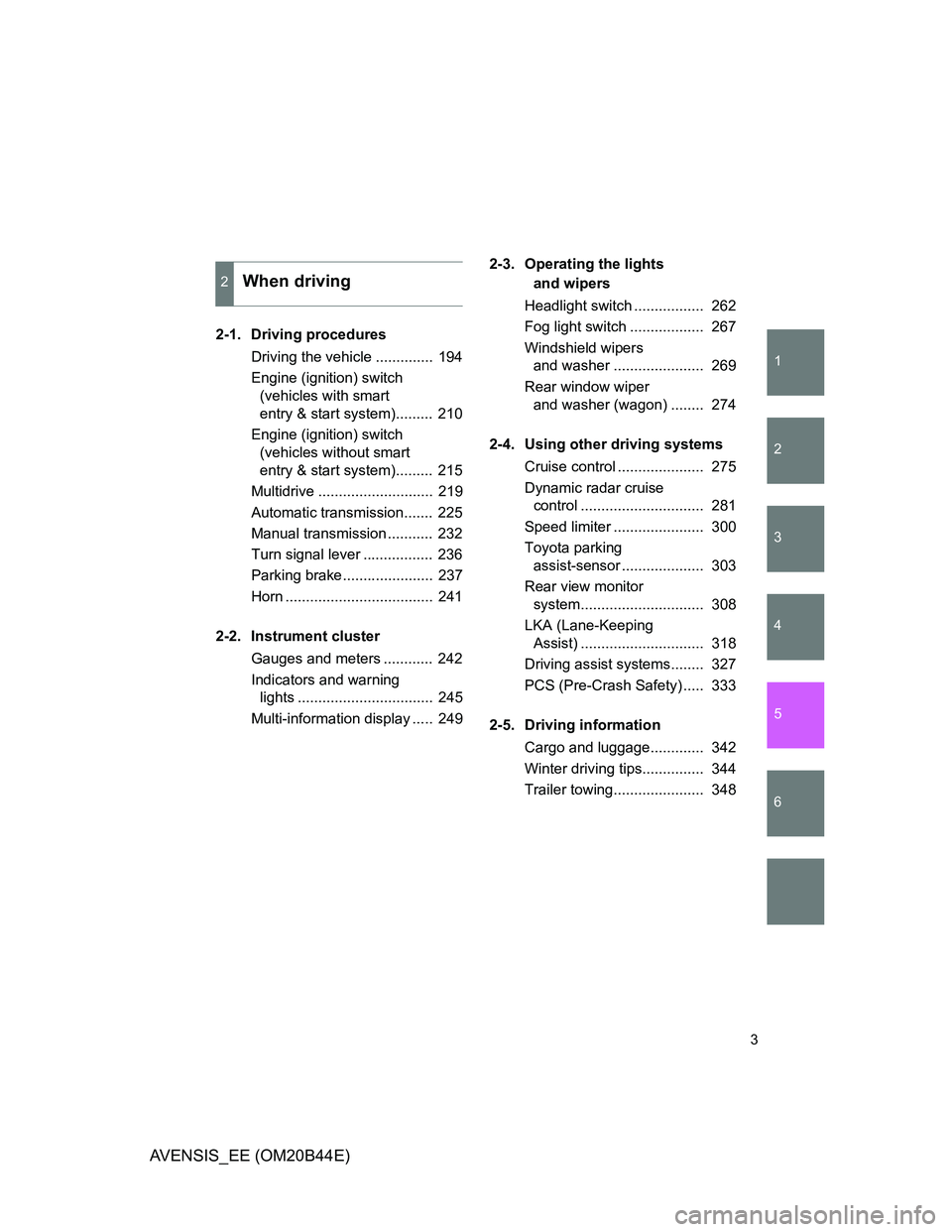
1
2
3
4
5
6
3
AVENSIS_EE (OM20B44E)
2-1. Driving procedures
Driving the vehicle .............. 194
Engine (ignition) switch
(vehicles with smart
entry & start system)......... 210
Engine (ignition) switch
(vehicles without smart
entry & start system)......... 215
Multidrive ............................ 219
Automatic transmission....... 225
Manual transmission ........... 232
Turn signal lever ................. 236
Parking brake...................... 237
Horn .................................... 241
2-2. Instrument cluster
Gauges and meters ............ 242
Indicators and warning
lights ................................. 245
Multi-information display ..... 2492-3. Operating the lights
and wipers
Headlight switch ................. 262
Fog light switch .................. 267
Windshield wipers
and washer ...................... 269
Rear window wiper
and washer (wagon) ........ 274
2-4. Using other driving systems
Cruise control ..................... 275
Dynamic radar cruise
control .............................. 281
Speed limiter ...................... 300
Toyota parking
assist-sensor .................... 303
Rear view monitor
system.............................. 308
LKA (Lane-Keeping
Assist) .............................. 318
Driving assist systems........ 327
PCS (Pre-Crash Safety) ..... 333
2-5. Driving information
Cargo and luggage............. 342
Winter driving tips............... 344
Trailer towing...................... 348
2When driving
Page 82 of 772
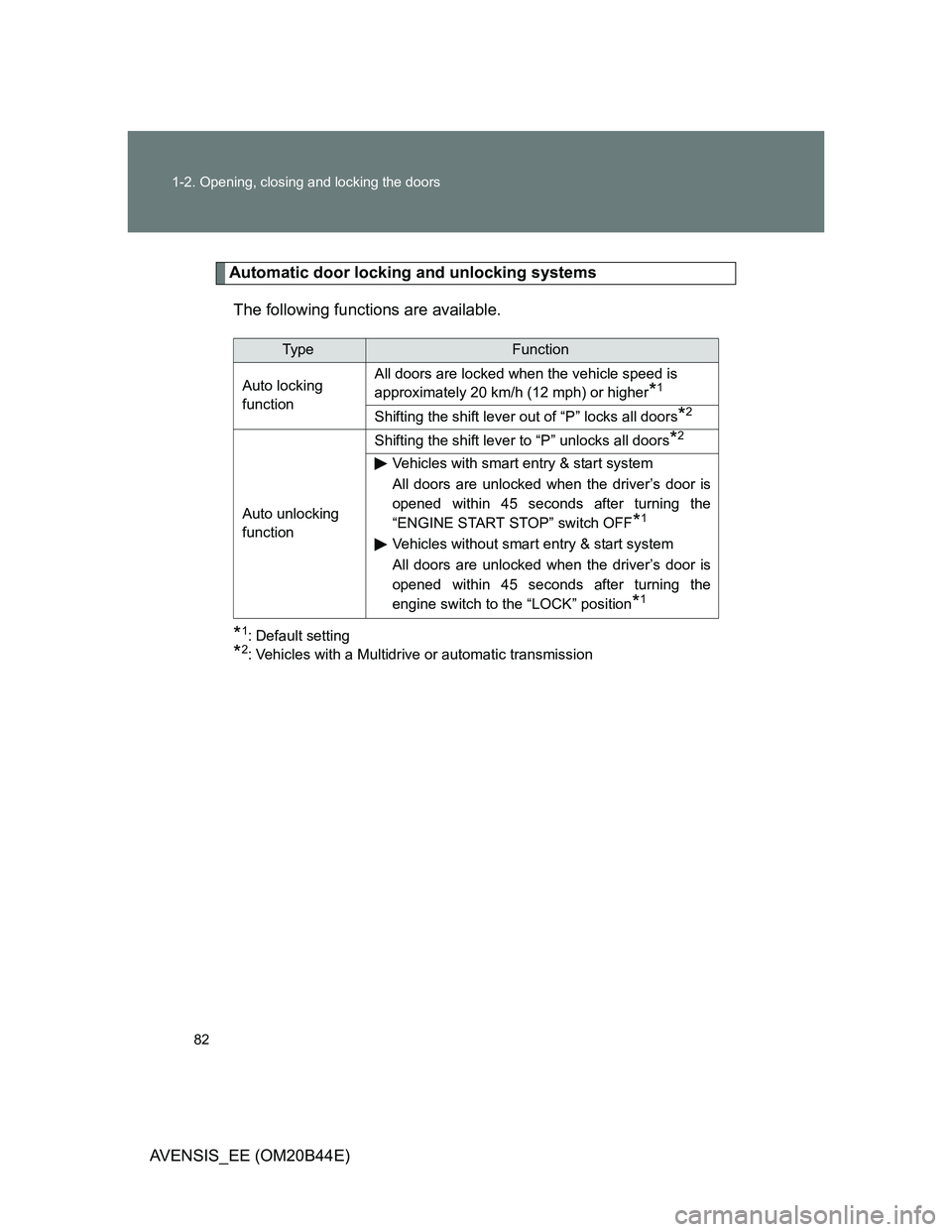
82 1-2. Opening, closing and locking the doors
AVENSIS_EE (OM20B44E)
Automatic door locking and unlocking systems
The following functions are available.
*1: Default setting
*2: Vehicles with a Multidrive or automatic transmission
Ty p eFunction
Auto locking
functionAll doors are locked when the vehicle speed is
approximately 20 km/h (12 mph) or higher
*1
Shifting the shift lever out of “P” locks all doors*2
Auto unlocking
functionShifting the shift lever to “P” unlocks all doors
*2
Vehicles with smart entry & start system
All doors are unlocked when the driver’s door is
opened within 45 seconds after turning the
“ENGINE START STOP” switch OFF
*1
Vehicles without smart entry & start system
All doors are unlocked when the driver’s door is
opened within 45 seconds after turning the
engine switch to the “LOCK” position
*1
Page 104 of 772
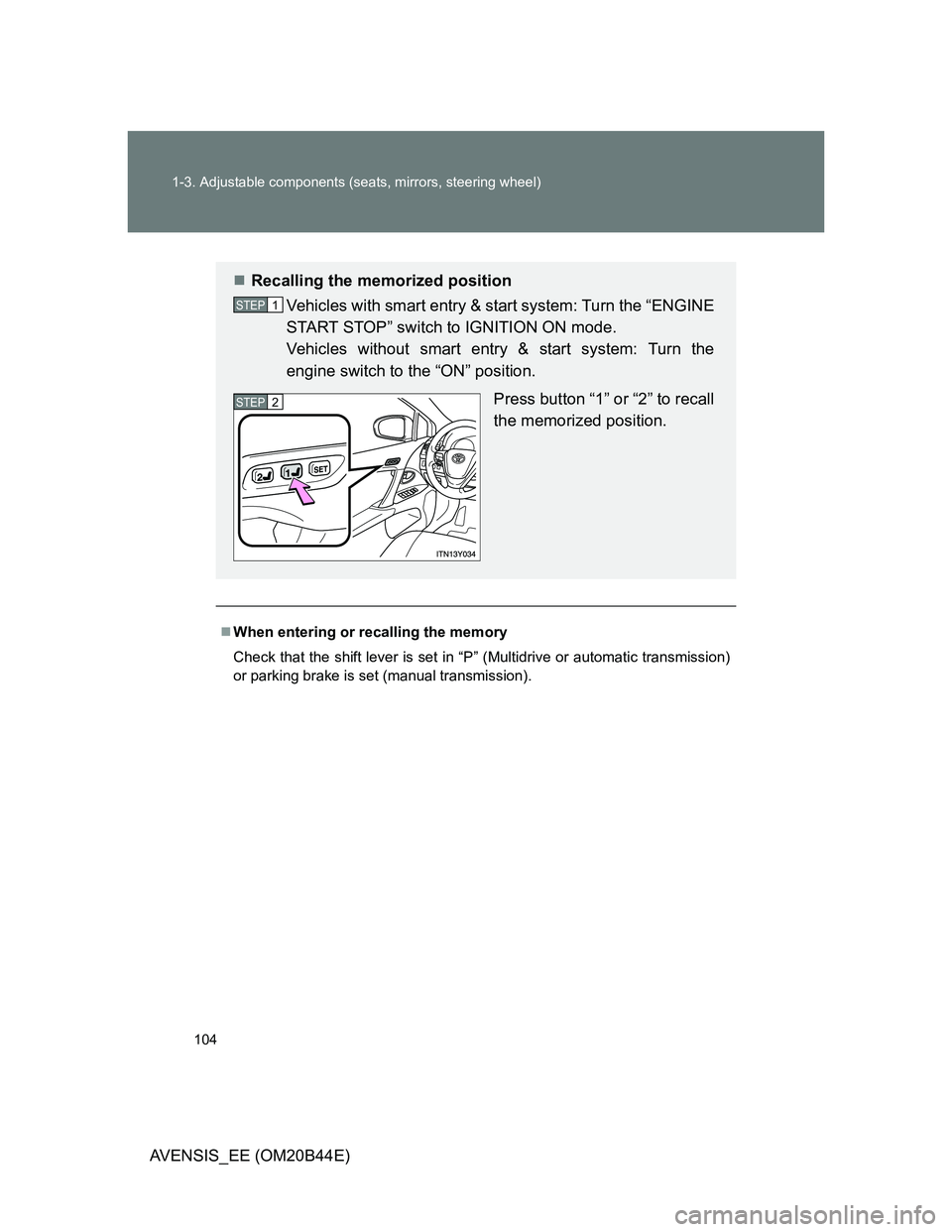
104 1-3. Adjustable components (seats, mirrors, steering wheel)
AVENSIS_EE (OM20B44E)
When entering or recalling the memory
Check that the shift lever is set in “P” (Multidrive or automatic transmission)
or parking brake is set (manual transmission).
Recalling the memorized position
Vehicles with smart entry & start system: Turn the “ENGINE
START STOP” switch to IGNITION ON mode.
Vehicles without smart entry & start system: Turn the
engine switch to the “ON” position.
Press button “1” or “2” to recall
the memorized position.
STEP1
STEP2
Page 193 of 772
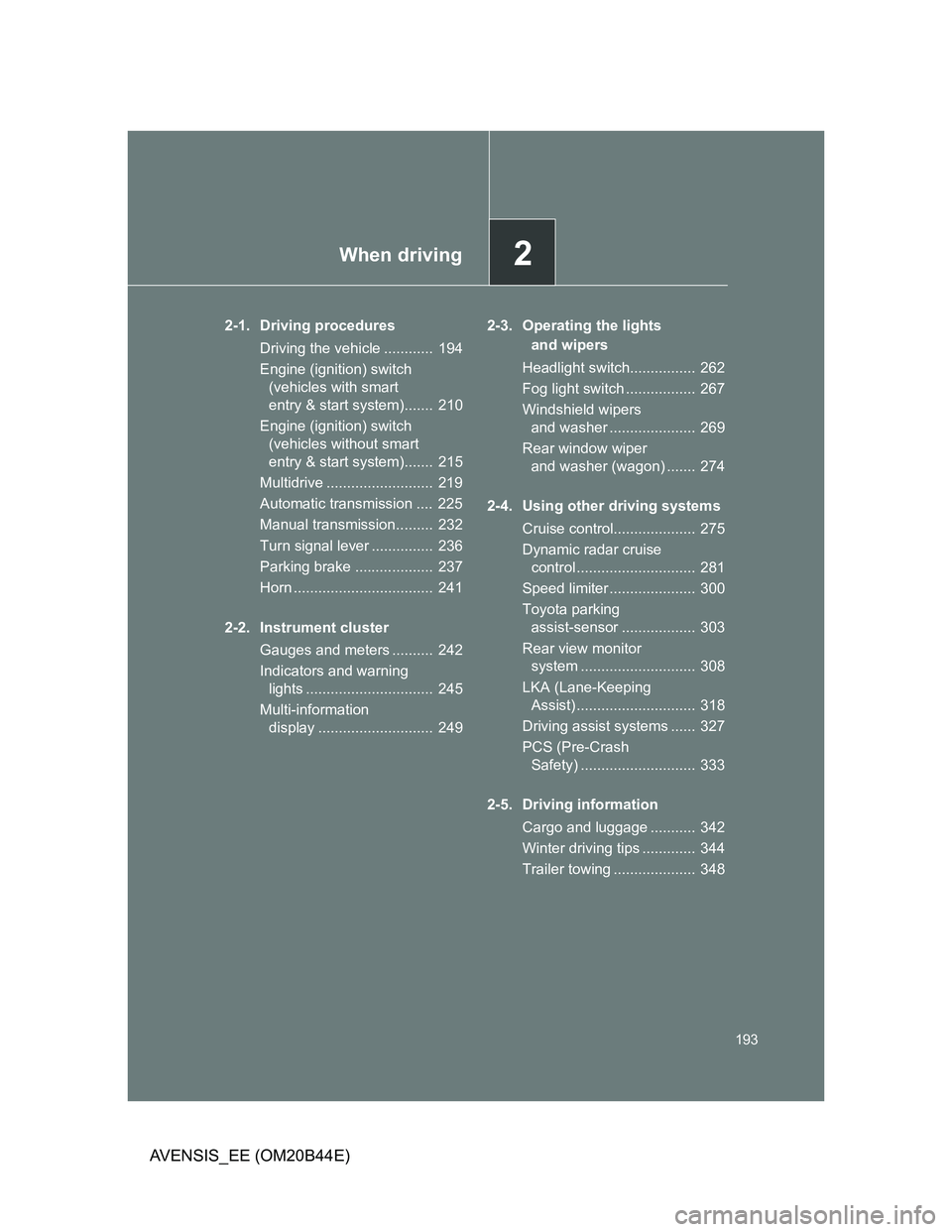
2When driving
193
AVENSIS_EE (OM20B44E)
2-1. Driving procedures
Driving the vehicle ............ 194
Engine (ignition) switch
(vehicles with smart
entry & start system)....... 210
Engine (ignition) switch
(vehicles without smart
entry & start system)....... 215
Multidrive .......................... 219
Automatic transmission .... 225
Manual transmission......... 232
Turn signal lever ............... 236
Parking brake ................... 237
Horn .................................. 241
2-2. Instrument cluster
Gauges and meters .......... 242
Indicators and warning
lights ............................... 245
Multi-information
display ............................ 2492-3. Operating the lights
and wipers
Headlight switch................ 262
Fog light switch ................. 267
Windshield wipers
and washer ..................... 269
Rear window wiper
and washer (wagon) ....... 274
2-4. Using other driving systems
Cruise control.................... 275
Dynamic radar cruise
control ............................. 281
Speed limiter ..................... 300
Toyota parking
assist-sensor .................. 303
Rear view monitor
system ............................ 308
LKA (Lane-Keeping
Assist) ............................. 318
Driving assist systems ...... 327
PCS (Pre-Crash
Safety) ............................ 333
2-5. Driving information
Cargo and luggage ........... 342
Winter driving tips ............. 344
Trailer towing .................... 348
Page 194 of 772
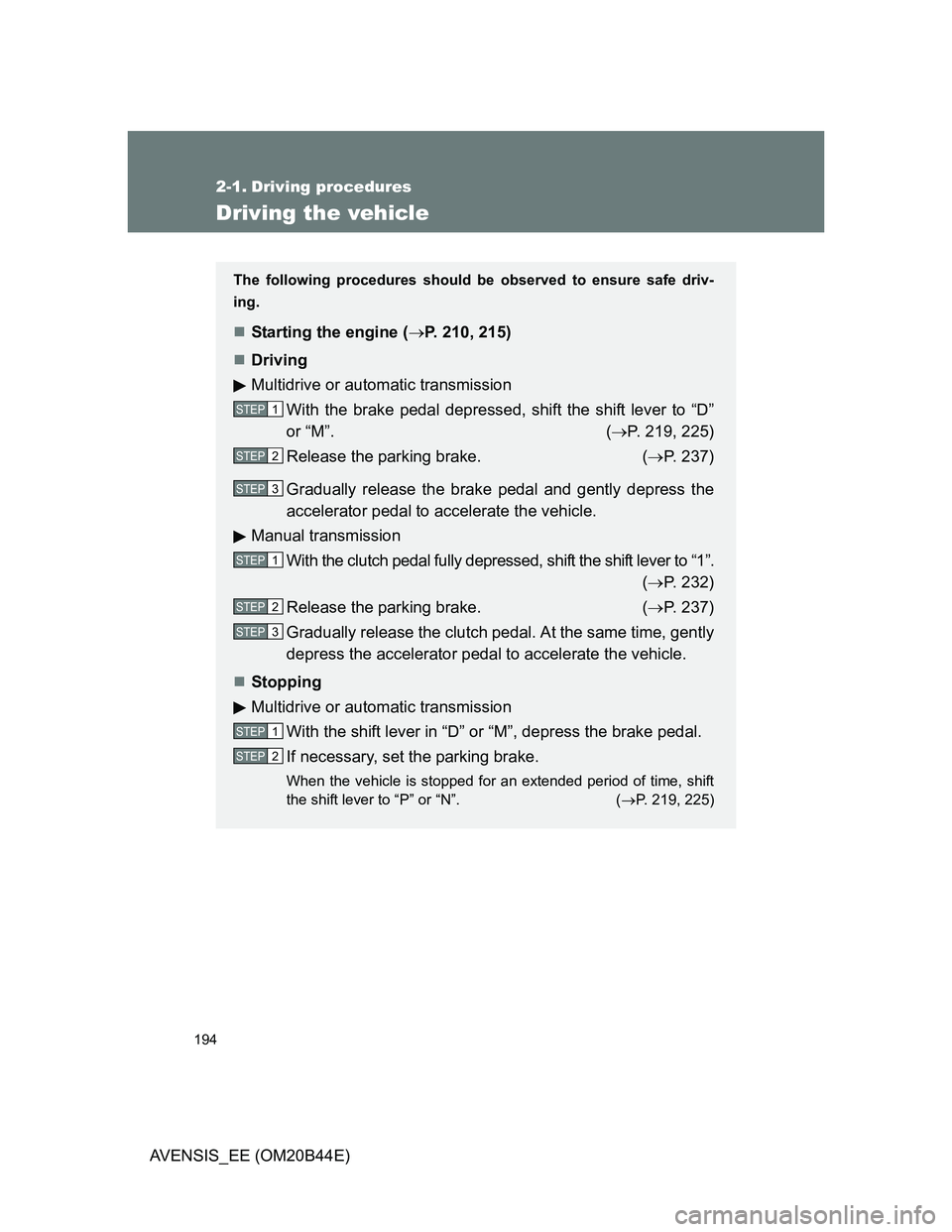
194
AVENSIS_EE (OM20B44E)
2-1. Driving procedures
Driving the vehicle
The following procedures should be observed to ensure safe driv-
ing.
Starting the engine (P. 210, 215)
Driving
Multidrive or automatic transmission
With the brake pedal depressed, shift the shift lever to “D”
or “M”. (P. 219, 225)
Release the parking brake. (P. 237)
Gradually release the brake pedal and gently depress the
accelerator pedal to accelerate the vehicle.
Manual transmission
With the clutch pedal fully depressed, shift the shift lever to “1”.
(P. 232)
Release the parking brake. (P. 237)
Gradually release the clutch pedal. At the same time, gently
depress the accelerator pedal to accelerate the vehicle.
Stopping
Multidrive or automatic transmission
With the shift lever in “D” or “M”, depress the brake pedal.
If necessary, set the parking brake.
When the vehicle is stopped for an extended period of time, shift
the shift lever to “P” or “N”. (P. 219, 225)
STEP1
STEP2
STEP3
STEP1
STEP2
STEP3
STEP1
STEP2
Page 195 of 772

195 2-1. Driving procedures
2
When driving
AVENSIS_EE (OM20B44E)
Manual transmission
With the clutch pedal fully depressed, depress the brake
pedal.
If necessary, set the parking brake.
When the vehicle is stopped for an extended period of time, shift
the shift lever to “N”. (P. 232)
Parking the vehicle
Multidrive or automatic transmission
With the shift lever in “D” or “M”, depress the brake pedal.
Set the parking brake. (P. 237)
Shift the shift lever to “P”. (P. 219, 225)
When parking on a hill, if necessary, block the wheels.
Vehicles with smart entry & start system: Turn the “ENGINE
START STOP” switch OFF and stop the engine.
Vehicles without smart entry & start system: Turn the
engine switch to the “LOCK” position and stop the engine.
Lock the door, making sure that you have the key on your
person.
STEP1
STEP2
STEP1
STEP2
STEP3
STEP4
STEP5
Page 197 of 772
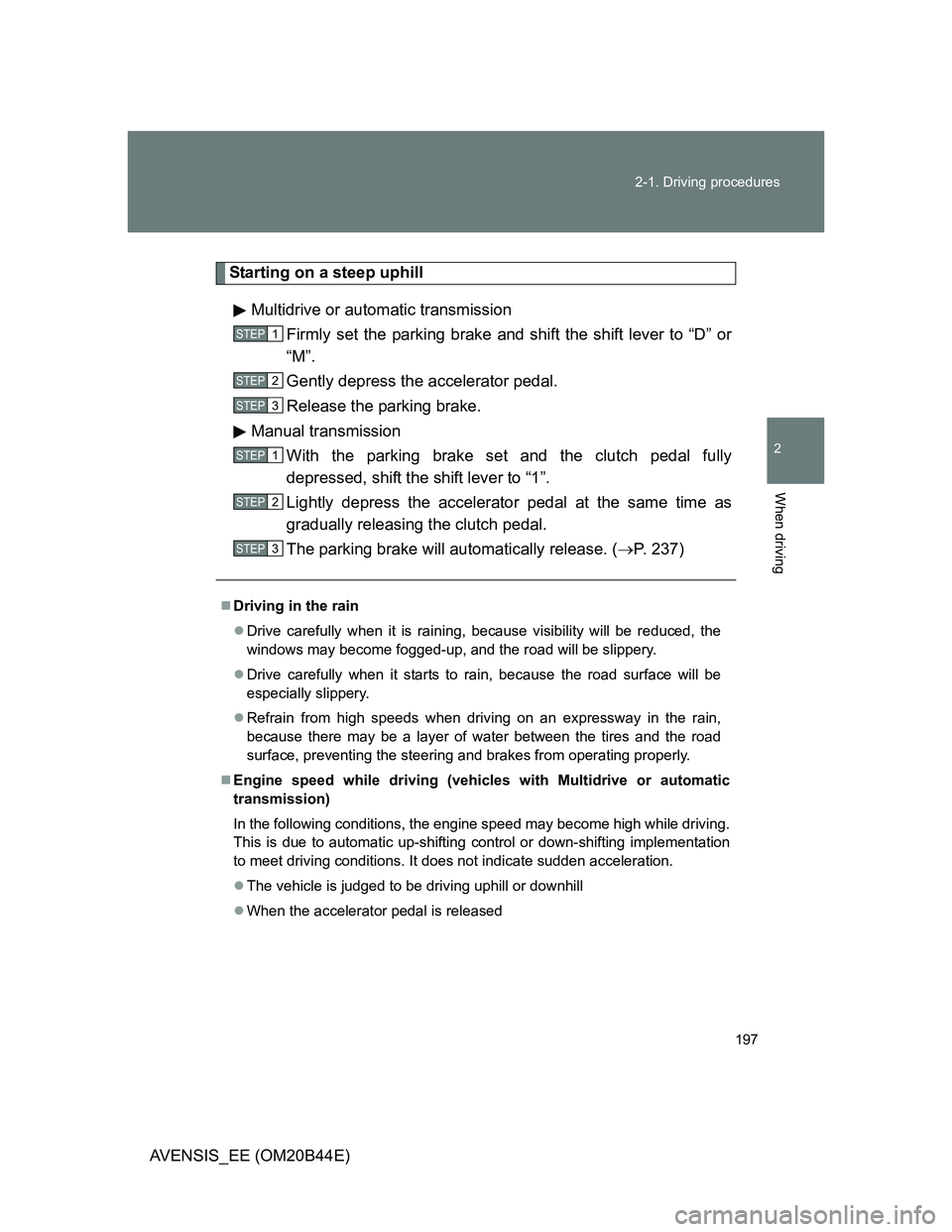
197 2-1. Driving procedures
2
When driving
AVENSIS_EE (OM20B44E)
Starting on a steep uphill
Multidrive or automatic transmission
Firmly set the parking brake and shift the shift lever to “D” or
“M”.
Gently depress the accelerator pedal.
Release the parking brake.
Manual transmission
With the parking brake set and the clutch pedal fully
depressed, shift the shift lever to “1”.
Lightly depress the accelerator pedal at the same time as
gradually releasing the clutch pedal.
The parking brake will automatically release. (P. 237)
Driving in the rain
Drive carefully when it is raining, because visibility will be reduced, the
windows may become fogged-up, and the road will be slippery.
Drive carefully when it starts to rain, because the road surface will be
especially slippery.
Refrain from high speeds when driving on an expressway in the rain,
because there may be a layer of water between the tires and the road
surface, preventing the steering and brakes from operating properly.
Engine speed while driving (vehicles with Multidrive or automatic
transmission)
In the following conditions, the engine speed may become high while driving.
This is due to automatic up-shifting control or down-shifting implementation
to meet driving conditions. It does not indicate sudden acceleration.
The vehicle is judged to be driving uphill or downhill
When the accelerator pedal is released
STEP1
STEP2
STEP3
STEP1
STEP2
STEP3
Page 199 of 772
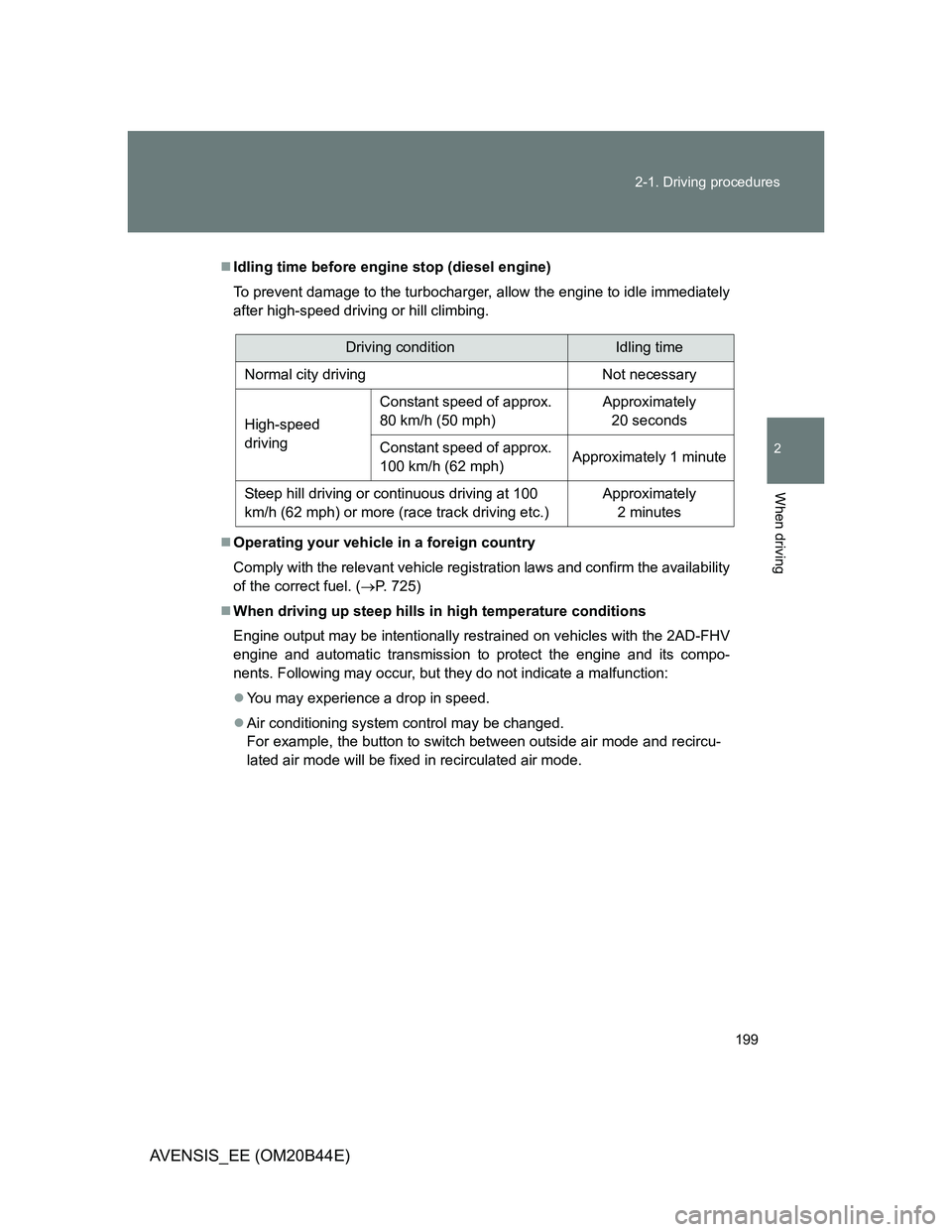
199 2-1. Driving procedures
2
When driving
AVENSIS_EE (OM20B44E)
Idling time before engine stop (diesel engine)
To prevent damage to the turbocharger, allow the engine to idle immediately
after high-speed driving or hill climbing.
Operating your vehicle in a foreign country
Comply with the relevant vehicle registration laws and confirm the availability
of the correct fuel. (P. 725)
When driving up steep hills in high temperature conditions
Engine output may be intentionally restrained on vehicles with the 2AD-FHV
engine and automatic transmission to protect the engine and its compo-
nents. Following may occur, but they do not indicate a malfunction:
You may experience a drop in speed.
Air conditioning system control may be changed.
For example, the button to switch between outside air mode and recircu-
lated air mode will be fixed in recirculated air mode.
Driving conditionIdling time
Normal city driving Not necessary
High-speed
drivingConstant speed of approx.
80 km/h (50 mph)Approximately
20 seconds
Constant speed of approx.
100 km/h (62 mph)Approximately 1 minute
Steep hill driving or continuous driving at 100
km/h (62 mph) or more (race track driving etc.)Approximately
2 minutes
Page 200 of 772
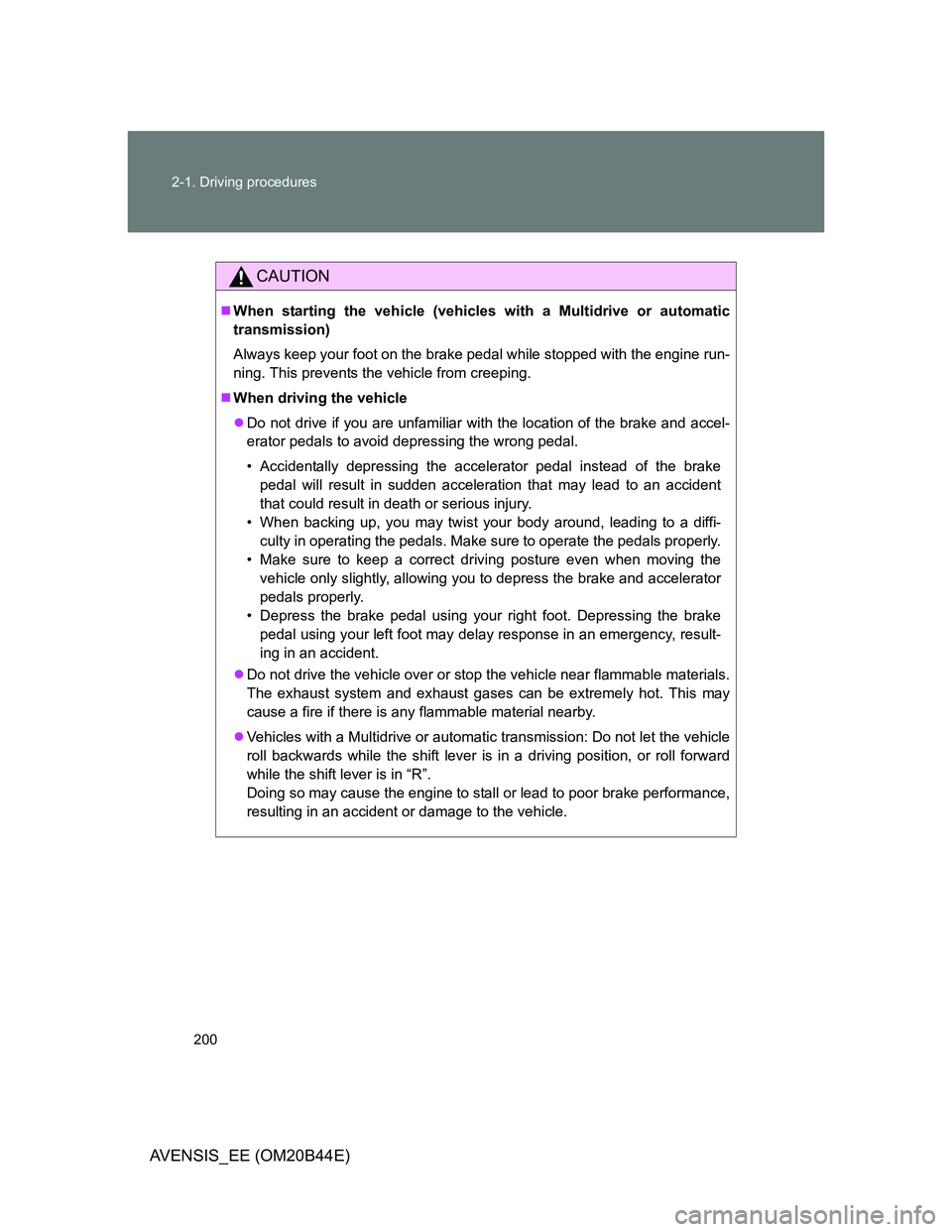
200 2-1. Driving procedures
AVENSIS_EE (OM20B44E)
CAUTION
When starting the vehicle (vehicles with a Multidrive or automatic
transmission)
Always keep your foot on the brake pedal while stopped with the engine run-
ning. This prevents the vehicle from creeping.
When driving the vehicle
Do not drive if you are unfamiliar with the location of the brake and accel-
erator pedals to avoid depressing the wrong pedal.
• Accidentally depressing the accelerator pedal instead of the brake
pedal will result in sudden acceleration that may lead to an accident
that could result in death or serious injury.
• When backing up, you may twist your body around, leading to a diffi-
culty in operating the pedals. Make sure to operate the pedals properly.
• Make sure to keep a correct driving posture even when moving the
vehicle only slightly, allowing you to depress the brake and accelerator
pedals properly.
• Depress the brake pedal using your right foot. Depressing the brake
pedal using your left foot may delay response in an emergency, result-
ing in an accident.
Do not drive the vehicle over or stop the vehicle near flammable materials.
The exhaust system and exhaust gases can be extremely hot. This may
cause a fire if there is any flammable material nearby.
Vehicles with a Multidrive or automatic transmission: Do not let the vehicle
roll backwards while the shift lever is in a driving position, or roll forward
while the shift lever is in “R”.
Doing so may cause the engine to stall or lead to poor brake performance,
resulting in an accident or damage to the vehicle.
Page 201 of 772
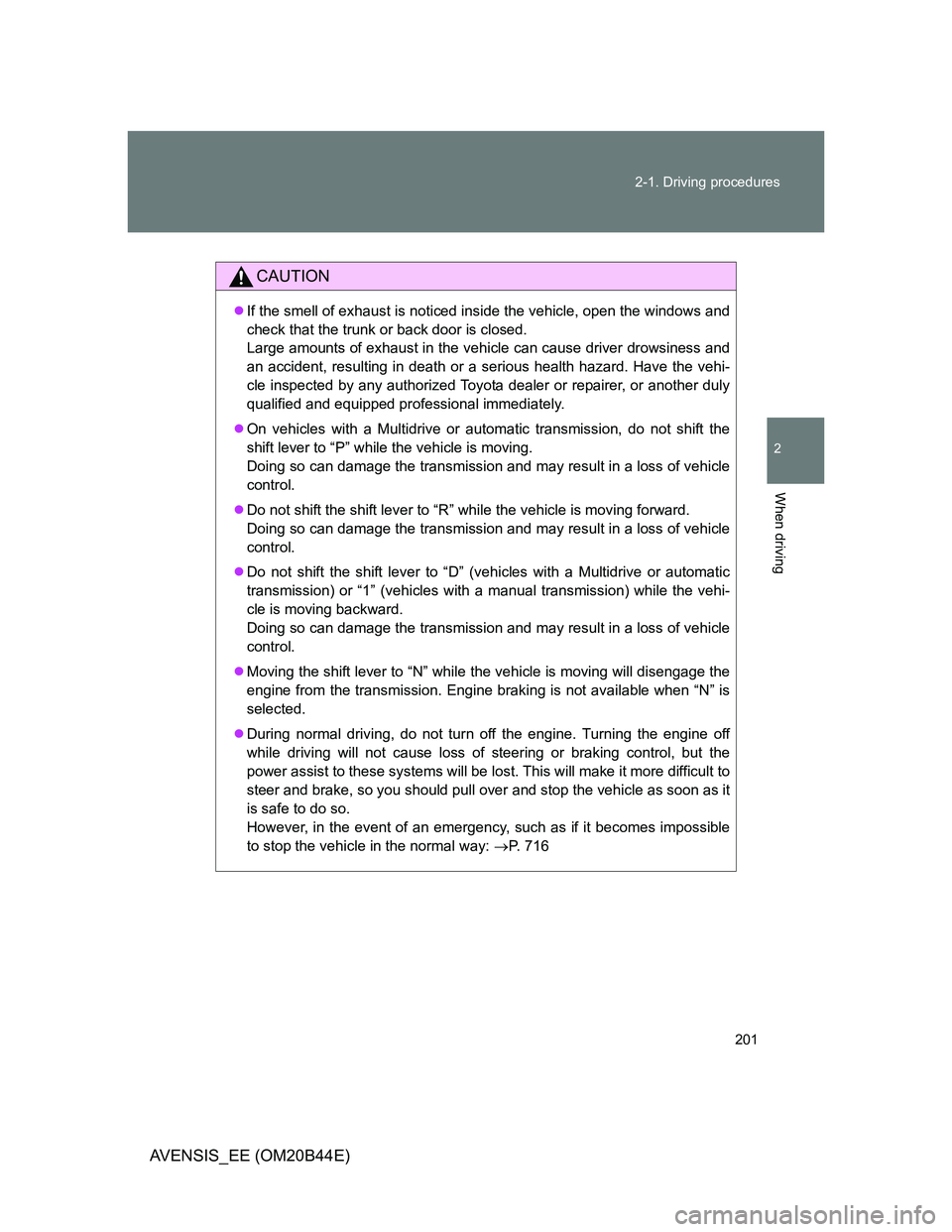
201 2-1. Driving procedures
2
When driving
AVENSIS_EE (OM20B44E)
CAUTION
If the smell of exhaust is noticed inside the vehicle, open the windows and
check that the trunk or back door is closed.
Large amounts of exhaust in the vehicle can cause driver drowsiness and
an accident, resulting in death or a serious health hazard. Have the vehi-
cle inspected by any authorized Toyota dealer or repairer, or another duly
qualified and equipped professional immediately.
On vehicles with a Multidrive or automatic transmission, do not shift the
shift lever to “P” while the vehicle is moving.
Doing so can damage the transmission and may result in a loss of vehicle
control.
Do not shift the shift lever to “R” while the vehicle is moving forward.
Doing so can damage the transmission and may result in a loss of vehicle
control.
Do not shift the shift lever to “D” (vehicles with a Multidrive or automatic
transmission) or “1” (vehicles with a manual transmission) while the vehi-
cle is moving backward.
Doing so can damage the transmission and may result in a loss of vehicle
control.
Moving the shift lever to “N” while the vehicle is moving will disengage the
engine from the transmission. Engine braking is not available when “N” is
selected.
During normal driving, do not turn off the engine. Turning the engine off
while driving will not cause loss of steering or braking control, but the
power assist to these systems will be lost. This will make it more difficult to
steer and brake, so you should pull over and stop the vehicle as soon as it
is safe to do so.
However, in the event of an emergency, such as if it becomes impossible
to stop the vehicle in the normal way: P. 716